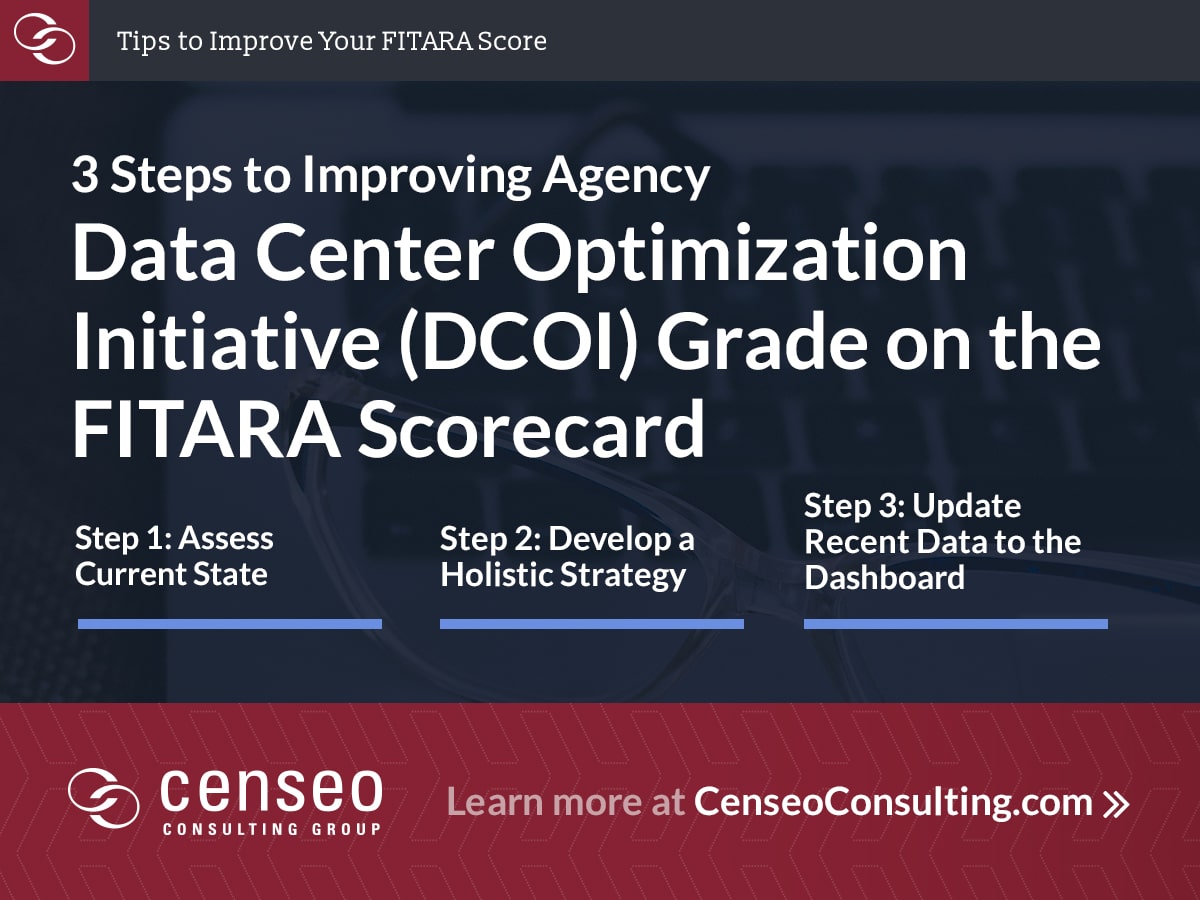This is the fourth in a series of posts to address how agencies can improve their efficiency and effectiveness in regards to their FITARA scorecard. In the first blog post, we addressed three steps your agency can take to get a better MEGABYTE grade on the FITARA scorecard. In the second we touched on steps your agency can follow to improve its Incremental Development grade. Then most recently, we discussed some tactics your agency can use to earn higher marks on the Transparency and Risk Management section of the FITARA scorecard. In today’s post we’re talking about improving your Data Center Optimization Initiative (DCOI) grades.
Let’s review for a moment. What is FITARA? FITARA stands for the Federal Information Technology Acquisition Reform Act. This act was passed by Congress in 2014. What are the objectives of FITARA? FITARA’s stated intent is to help federal agencies reduce IT waste, improve how information technology is purchased and managed, and drive technology reform across all federal agencies. A quarterly scorecard grades agencies on how well they’re doing with these initiatives.
So, how’s it been going over the past four years? The answer- not well. Only one agency received an ‘A’ on the latest scorecard released by the House oversight committee in November 2017. 21 agencies saw their scores remain the same or go down. Only three agencies improved their scores! Clearly, there’s progress to be made.
Today we’re discussing the Data Center Optimization Initiative (DCOI) component of FITARA. The federal government spends over $5B on physical data centers. For nearly a decade the Office of Management and Budget (OMB) has pushed federal agencies to reduce the government’s data center footprint. DCOI was established policy as of August 1, 2016 and superseded the Federal Data Center Consolidation Initiative (FDCCI) from 2010. This dimension of the FITARA scorecard is designed to measure an agency’s progress toward this goal.
According to GSA, the Data Center Optimization Initiative requires federal agencies to:
- Develop and report on data center strategies.
- Transition to more efficient infrastructure, such as cloud services and inter-agency shared services.
- Leverage technology advancements to optimize infrastructure.
- Provide quality services for the public good.
There are three key steps to making progress and demonstrating improvement with regard to DCOI objectives.
Step 1: Assess Current State
The first step is to assess the agency’s current state with regard to data centers and their use:
- Inventory: Conduct a census of all physical data centers, the number and types of servers in each center, and their use. Remember: even a server or two in a “closet” can be considered a data center if it’s providing services “whether in a production, test, staging, development, or any other environment.” This goes all the up way to a huge warehouse with thousands of machines spinning.
- “Crawlers”: Deploy Automated Monitoring tools, often called “crawlers”, to monitor utilization of servers. This will help prioritize decommissioning or merging underutilized devices.
- Synthesis: Analyze your data to identify 1). the number of servers in use, 2). server utilization patterns, 3). the overall costs of maintaining those servers, and 4). mission critical uses that cannot be moved to the cloud for validated security or other reasons.
Step 2: Develop a Holistic Strategy
Now that you have a better understanding on what data centers your agency has and is running, you’re in a position to develop a strategy. Here are some items to consider:
- 5 elements: Develop a strategy that will enable your agency to meet the 5 key consolidation metrics:
- Server Utilization & Automated Monitoring
- Energy Metering
- Power Usage Effectiveness
- Facility Utilization
- Virtualization
- Cloud?: According to the DCOI memorandum, “Agencies shall use cloud infrastructure where possible when planning new mission or support applications or consolidating existing applications.” Determine the degree to which your agency will implement cloud solutions. Be realistic and consider technology and security requirements, concerns with data rights, the skills of IT staff, hidden costs, and cultural barriers. Don’t forget to look at software license requirements.
- Templates: Given that it’s likely your data center footprint is geographically diverse, develop a simple template to collect data from across the agency to facilitate centralized reporting
- Methodologies: Review savings methodologies for the Data Center Optimization Initiative to ensure standards are consistently applied across offices, locations, and reporting mechanisms.
Step 3: Update Recent Data to the Dashboard
As we’ve discussed, it’s very important that you report your progress. Remember: Your FITARA scorecard grade is based on what you report to the IT dashboard. Be sure to upload your data in a timely manner.
- Report to OMB: Report savings and progress on the central plan for each of the 5 strategic elements to OMB each quarter.
As a result of following these steps, your agency will be able to move towards creating a wholistic approach to implementing data center optimization best practices which will allow your data center to operate more effectively and efficiently.
If you are interested in receiving more details on how Censeo Consulting can help your organization implement data center optimization and management best practices and policies, contact us today to schedule a consultation.
Let Our Team of Experts Help you Today




